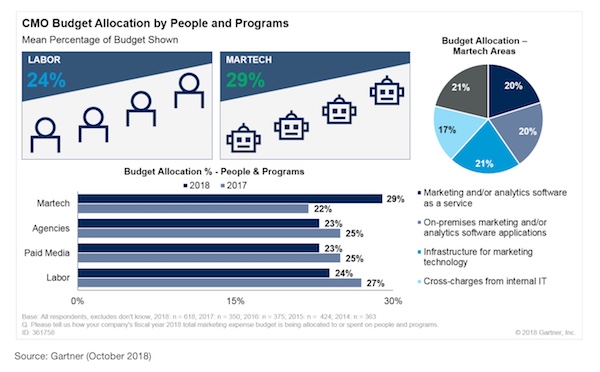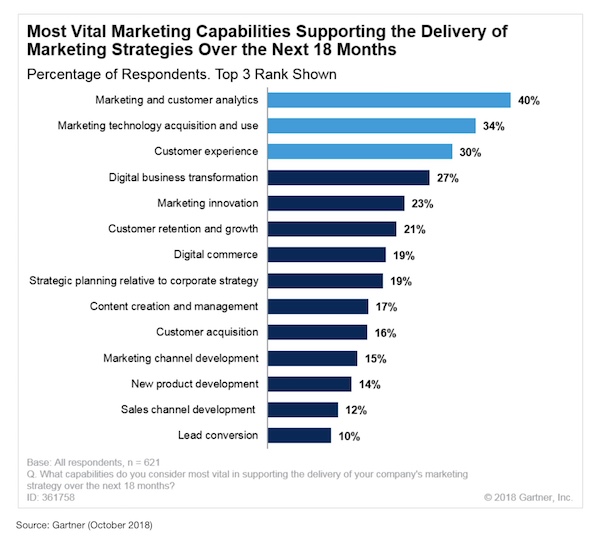When Gartner’s annual CMO Spend Survey for 2017-2018 came out last year, many people seized on the fact that the money CMOs allocated for marketing technology had dropped to 22% of their budget, on average, down from 27% the year before.
Some took it as an unmistakable sign of an impending martech apocalypse (“martech-alypse?”).
I actually thought that 22% was a pretty good level of investment in martech. The fact that some budget was redistributed to services and paid media didn’t strike me as a retreat from martech, but rather a sign of marketing departments leaning more towards applying their marketing stacks to (hopefully) good use.
The fact is: martech is deeply and permanently embedded in the strategy and operations of marketing for the rest of, well, forever. Budgets and vendor landscapes will fluctuate — maybe even dramatically in some years — but martech is here to stay, as sure as electricity and swag.
But if you were concerned — or hopeful, for those naysayers out there — that martech was waning, Gartner’s new CMO Spend Survey for 2018-2019 delivers evidence to the contrary. The average percentage of a CMO’s budget allocated for martech jumped from 22% to 29%. That’s nearly 1/3 higher.
To quote directly from Gartner’s report (emphasis added is mine):
Marketing technology has accounted for an increasingly significant share of marketing expense budgets in recent years. In 2018, this march of martech shows no signs of slowing down. Up from 22% in 2017, martech now accounts for a whopping 29% of the total marketing expense budget, making martech the single largest area of investment when it comes to marketing resources and programs.
Even though marketing budgets overall dipped a little on average — down from 11.3% to 11.2% of total company expenses — the absolute investment in marketing technology still rose. 29% of 11.2% represents 3.25% of total company spend on martech for 2018-2019, compared to 2.49% (22% of 11.3%) last year.
Now, I wouldn’t infer too much from this, other than martech spending will remain healthy for this next year. But it is interesting that, in contrast, only 24% of the marketing budget on average is allocated to in-house marketing labor (plus another 23% for agencies). Are we not investing enough in our human capital? Or is martech giving our employees greater leverage?
You could argue that either way — the correct answer is probably “both.”
Analytics & martech are the most vital marketing capabilities
As part of this study, Gartner also asked CMOs to identify the most vital marketing capabilities supporting the delivery of marketing strategies over the next 18 months. CMOs had to pick their top three — hey, not everything can be most vital, even though it often feels that way.
The highest ranking capabilities CMOs chose:
- Marketing and customer analytics (40%)
- Marketing technology acquisition and use (34%)
- Customer experience (30%)
Some might object that classic marketing capabilities such as “customer retention and growth” (21%) and “customer acquisition” (16%) are ranked significantly lower on this list. It invites the argument that marketing has become too obsessed with technology and data at the expense of its fundamentals.
That’s undoubtedly true in some organizations. But for most, there’s likely a rational distinction between capability and objective. Marketing leaders are focused on building their analytics and martech capabilities because they’re the muscle groups that need the most development. But the whole purpose of developing those capabilities is to deliver better outcomes in their core objectives of customer acquisition and retention.
Analytics and martech capabilities aren’t at the expense of customer acquisition and retention. They’re the means to that end in a hyper-competitive digital world.
Developing these capabilities is not simply a matter of buying more technology. To dismiss these top CMO priorities as a shallow techno-fetish is a mistake. The hard work is rethinking how marketing is managed to leverage that technology effectively. Great CMOs fully appreciate this.
And it’s most certainly driven through the lens of winning happy and loyal customers.
This is why “customer experience” is the third highest ranked capability on this list, which is a testament to CMOs belief that the customer is at the very center of their mission. Not just at the point of discovery or conversion or limited solely to the domain of traditional marketing touchpoints. The whole customer experience.
To quote a stat from the Gartner report: “CMOs estimate that 18% of their overall marketing budgets are allocated to customer experience initiatives. This spending is embedded across multiple marketing activities, such as the website and digital commerce.”
This too is a new muscle group for most CMOs: learning to effectively collaborate with many different teams outside of the marketing department to engage and delight customers across organizational boundaries.
Overall, I’m encouraged by the results of this year’s study, pointing towards increasing maturity in marketing technology and operations in 2019.
P.S. As regular readers know, I’ve become fascinated with citizen developers and their impact on marketing’s capabilities. It’s worth nothing that 17% of the martech budget in Gartner’s survey was allocated to charge-backs from internal IT. I predict this will be a driver for greater adoption of citizen development platforms over the next year — more bandwidth at less cost.







